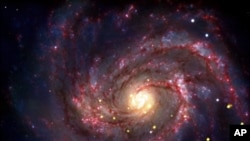An orbiting NASA telescope has detected evidence of what may be the youngest black hole yet discovered and, at 50 million light years away, it is relatively close to Earth.
The object resulted from a supernova first observed by an American amateur astronomer just three decades ago.
The astronomer, a school teacher named Gus Johnson, first observed the massive explosion that was labeled supernova 1979C. Observations in the years since found it was a powerful source of X-rays typical of black holes.
Black holes are regions that are so massive, their gravitational pull so strong, that not even light can escape. They can form at the end of a star's life. When a star has used up its nuclear fuel, its core can collapse and it becomes a supernova.
Daniel Patnaude, of the Harvard-Smithsonian Center for Astrophysics, who led a new study of this presumed black hole, says sometimes the result is a black hole while at other times it's a neutron star.
"Results such as this," he explained, "might actually be important because we don't know what the dividing line is between those supernova which form black holes, and those which form neutron stars."
After studying the x-rays from the object, Patnaude says there's no direct evidence that the supernova 1979C actually left behind a black hole. The X-ray signature detected by NASA's orbiting Chandra telescope provides only indirect evidence. But his colleague Avi Loeb says that if it is a black hole, it could provide important evidence of the energy sources that power a supernova. It also provides an opportunity to study some of the most extreme conditions that exist in the universe:
"Very high densities, close to that of an atomic nucleus," Loeb said. "And we cannot really reproduce these conditions in the laboratory. And so by observing the sky, we're able to learn about environments ... that can only be observed out there, in the universe."
Loeb and Patnaude will be publishing their findings in the journal "New Astronomy."
Astronomers have found numerous other black holes throughout the galaxy, but they've never seen one as it formed. That offers a unique research opportunity to observe the birth and early growth of one of the most mysterious objects in the sky.
"It's not just that possibly we have found the youngest nearby black hole," said NASA scientist Kimberly Weaver. "But what's really exciting about it is that we know the exact birth date of the black hole. We have found for the first time possibly the true birth date of a black hole."
And, as astronomers continue to study this object, they expect to gain new insight into how black holes expand by swallowing up nearby material.









